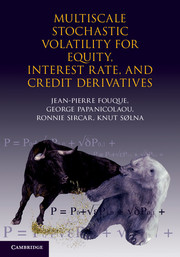Book contents
- Frontmatter
- Contents
- Introduction
- 1 The Black–Scholes Theory of Derivative Pricing
- 2 Introduction to Stochastic Volatility Models
- 3 Volatility Time Scales
- 4 First-Order Perturbation Theory
- 5 Implied Volatility Formulas and Calibration
- 6 Application to Exotic Derivatives
- 7 Application to American Derivatives
- 8 Hedging Strategies
- 9 Extensions
- 10 Around the Heston Model
- 11 Other Applications
- 12 Interest Rate Models
- 13 Credit Risk I: Structural Models with Stochastic Volatility
- 14 Credit Risk II: Multiscale Intensity-Based Models
- 15 Epilogue
- References
- Index
3 - Volatility Time Scales
Published online by Cambridge University Press: 07 October 2011
- Frontmatter
- Contents
- Introduction
- 1 The Black–Scholes Theory of Derivative Pricing
- 2 Introduction to Stochastic Volatility Models
- 3 Volatility Time Scales
- 4 First-Order Perturbation Theory
- 5 Implied Volatility Formulas and Calibration
- 6 Application to Exotic Derivatives
- 7 Application to American Derivatives
- 8 Hedging Strategies
- 9 Extensions
- 10 Around the Heston Model
- 11 Other Applications
- 12 Interest Rate Models
- 13 Credit Risk I: Structural Models with Stochastic Volatility
- 14 Credit Risk II: Multiscale Intensity-Based Models
- 15 Epilogue
- References
- Index
Summary
In this chapter, we introduce the characterization of stochastic volatility in terms of its time scales of fluctuation. This is self-contained and uses basic facts of probability theory which can be found in the textbooks referenced in the Notes at the end of the chapter. For most of the rest of the book, we will work with two-factor stochastic volatility models in which one factor is fast mean-reverting with respect to the time horizon of a typical options contract, while the other slow factor may not appear to be mean-reverting relative to this horizon, though it may be (and often is) mean-reverting over longer horizons. The option pricing problem under these multiscale stochastic volatility models is analyzed by asymptotic methods in Chapter 4. Among other applications, speedup of Monte Carlo simulations will be discussed in Section 11.1.
In the first part of the chapter, we will visualize time scales with pictures from numerical simulations. These will be used to illustrate the effect of fast and slow scales in the volatility on stock returns, which, unlike volatility, is the observable quantity we deal with in practice. We also provide illustrations with synthetic data in Section 3.4 and market data in Section 3.5.
A Simple Picture of Fast and Slow Time Scales
We present some simple examples of mean-reverting processes in the following sections. Mean-reversion refers to the typical time a process takes to return to its long-run mean level, if it exists.
- Type
- Chapter
- Information
- Publisher: Cambridge University PressPrint publication year: 2011
- 1
- Cited by

